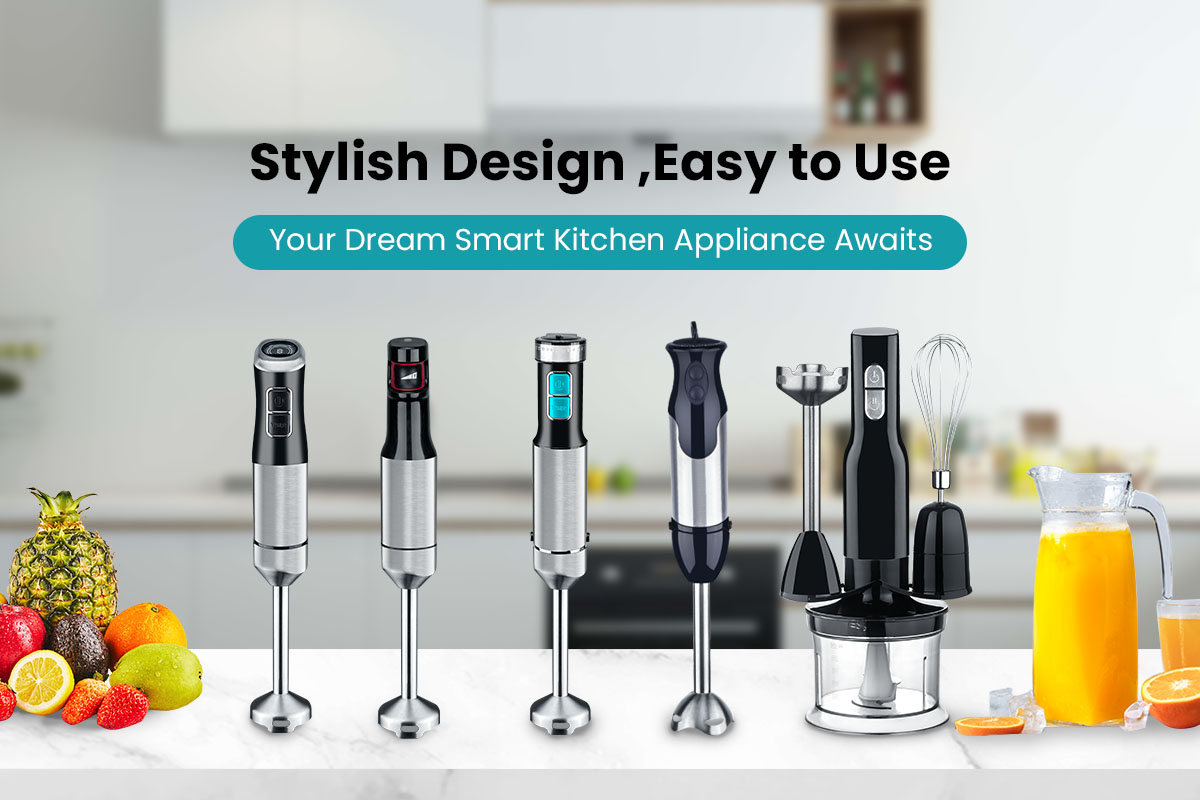Can Hand Blender Whip Egg White
Yes — a Hand Blender can whip egg whites, and it’s one of the quickest ways to achieve perfectly airy, stiff peaks for baking and cooking. Whether you’re making meringues, soufflés, macarons, or omelets, a good-quality hand blender can replace a traditional whisk or stand mixer for most tasks.
In this guide, you’ll learn how a hand blender whips egg whites, what attachments to use, and how to get professional results — with insights from KANGJIA Electrical Appliances Co., Ltd., a trusted manufacturer of high-performance hand blenders and small kitchen appliances.
1. The Short Answer
✅ Yes, you can whip egg whites with a hand blender.
The powerful motor and high-speed blades or whisk attachment help incorporate air quickly, turning liquid egg whites into fluffy foam.
However, to get the perfect result, you need the right technique, equipment, and timing — because over-whipping or improper setup can ruin the texture.
KANGJIA hand blenders feature variable speed control and stainless steel whisk attachments, allowing precise aeration for delicate mixtures like egg whites.
2. How a Hand Blender Whips Egg Whites
Whipping egg whites is essentially creating a stable foam by trapping air inside the proteins of the egg.
When you beat the whites, the protein molecules unfold and form a network around air bubbles.
The friction from the hand blender’s movement incorporates air quickly, making the foam expand.
As mixing continues, the foam transitions from frothy to soft peaks, then to stiff peaks.
| Stage | Appearance | Common Use |
|---|---|---|
| Foamy | Large bubbles, transparent | Soufflés, omelets |
| Soft Peaks | White and glossy, tips curl | Cakes, pancakes |
| Stiff Peaks | Firm and shiny, holds shape | Meringues, macarons |
The trick is knowing when to stop blending — over-mixing can cause the foam to collapse or become grainy.
3. What You Need
| Item | Description |
|---|---|
| Hand Blender | Preferably one with a whisk attachment |
| Egg Whites | Fresh and room temperature for best volume |
| Mixing Bowl | Clean, dry, non-plastic (metal or glass preferred) |
| Optional Additives | Cream of tartar, sugar, or salt to stabilize foam |
Important: The bowl and whisk must be completely free of oil or yolk, as fat prevents egg whites from foaming properly.
4. Step-by-Step: How to Whip Egg Whites with a Hand Blender
Step 1: Separate the Eggs
Carefully separate egg whites from yolks.
Ensure no traces of yolk are mixed in — even a drop can prevent proper foaming.
Step 2: Let Egg Whites Reach Room Temperature
Cold whites are harder to whip. Let them sit for about 15 minutes before starting.
Step 3: Choose the Right Attachment
Use the whisk attachment for best aeration.
If your hand blender doesn’t include a whisk, you can use the regular blending head, but it requires more control to avoid over-whipping.
Step 4: Start at Low Speed
Begin whipping at low speed for 20–30 seconds to break up the proteins and create uniform bubbles.
Step 5: Gradually Increase Speed
Raise to medium-high speed, moving the blender in gentle circular motions.
You’ll see the mixture turn white and thick within 1–2 minutes.
Step 6: Add Cream of Tartar or Sugar (Optional)
For more stable foam, add ⅛ tsp cream of tartar per egg white.
For sweet recipes like meringue, slowly add sugar once soft peaks form.
Step 7: Stop at Desired Peak
Stop blending once the whites form stiff peaks — the foam should stand upright when you lift the whisk.
KANGJIA hand blenders have precision speed control, making it easy to transition from gentle mixing to high-speed whipping without collapsing the foam.
5. Tips for Perfectly Whipped Egg Whites
| Tip | Reason |
|---|---|
| Use clean, dry tools | Oil and moisture prevent foam formation |
| Use room-temperature eggs | Proteins stretch more easily, trapping air better |
| Start slow, finish fast | Builds stable structure gradually |
| Avoid plastic bowls | They retain grease that destabilizes foam |
| Stop at stiff peaks | Over-whipped foam becomes grainy and unstable |
For maximum volume, choose a deep bowl and move the whisk vertically to pull in air efficiently.
6. Common Mistakes to Avoid
| Mistake | Result | Solution |
|---|---|---|
| Over-whipping | Foam becomes dry and clumpy | Add one extra egg white and fold gently |
| Using cold eggs | Low volume | Let them warm to room temperature |
| Greasy bowl | No foam formation | Wipe bowl with lemon juice or vinegar |
| Adding sugar too early | Slows foam buildup | Add sugar only after soft peaks form |
Over-whipping is the most common error — the foam looks thick but loses elasticity. The result will not fold well into batters.
7. Uses for Whipped Egg Whites
Whipped egg whites are essential in both sweet and savory dishes:
Meringues and pavlovas — crispy outside, soft inside
Macarons — smooth, glossy shells
Soufflés — light and airy texture
Cakes and mousses — volume and softness
Omelets — fluffy and tender consistency
KANGJIA hand blenders are versatile enough to handle all these applications, from whipping whites to blending batters and purees.
✅ Summary
| Step | Action | Key Tip |
|---|---|---|
| 1 | Separate eggs carefully | No yolk contamination |
| 2 | Warm whites slightly | Improves volume |
| 3 | Start on low speed | Builds stable foam |
| 4 | Increase gradually | Achieve soft or stiff peaks |
| 5 | Stop on time | Prevent collapse or dryness |
Final Thoughts
A hand blender is an excellent tool for whipping egg whites quickly and efficiently — especially when equipped with a whisk attachment. It saves time, minimizes effort, and delivers the same results as a hand mixer for most recipes.
With its powerful motor and ergonomic design, a KANGJIA hand blender makes whipping egg whites simple, fast, and consistent — from frothy omelets to glossy meringues.
The key to success is precision: clean tools, room-temperature eggs, and careful timing. Master these, and your hand blender will turn ordinary egg whites into light, fluffy perfection every time.
Previous: Can A Hand Mixer Replace A Blender





